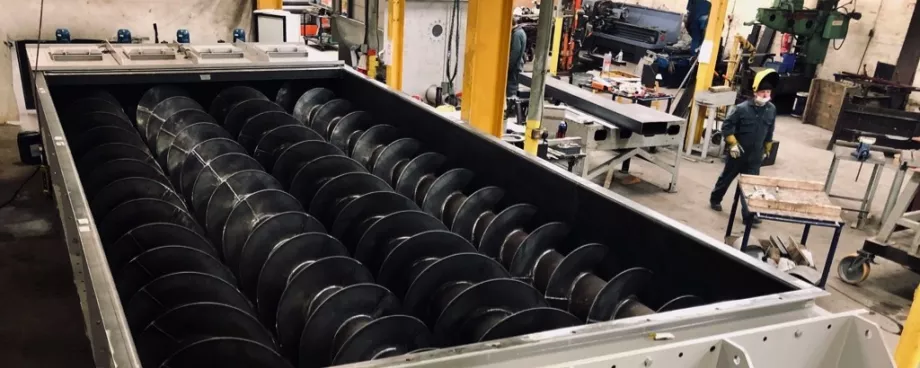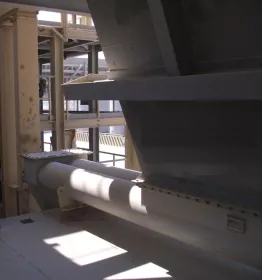
Converting the entire hopper to mass flow would be expensive so Ajax Equipment recommended replacing a 2-meter section at the bottom of the hopper as a cost-effective measure. Introducing the proposed vee-shaped section would exploit plane flow benefits as well as provide a large outlet from which a new twin screw feeder, featuring special extraction geometry, could actively draw material from the full length and width.
In addition to the new hopper section and screw feeder, a flow insert was also installed to further enhance deaeration and extend the flow benefits into the existing higher region of the hopper as well as prevent a direct flow path to the outlet. The flow insert also helped to minimise the plant modifications necessary to secure a reliable operating performance.
Following the improvements, reliable and stable discharge was achieved, the residence time of material is much more even and the twin screws deliver feed stability within 0.5%. Ian Hancock, operations manager at Bradley Pulverizer, commented on the project, “Since the equipment has been installed the performance of the process has significantly improved. By providing complete control over the flow of phosphate powder, Ajax’s equipment has enabled production of the high-quality product desired, a welcome improvement to plant performance which the plant operator describes as ‘the magic solution’.”
Four Screws - Waste to Energy
In 2020 Enviropower approached Ajax Equipment to discuss how best to replace a poorly performing walking floor discharger below a bunker at their waste to energy facility. The refuse derived fuel stored had a low, variable bulk density and a tendency to form ‘bird’s nests’; a combination of characteristics challenging for any feeding technology.
Following trials with a large twin screw feeder, Ajax designed and manufactured a screw feeder with four screws, each measuring eleven metres long. Ajax recommended a quadruple screw feeder as this would be able to serve the full length and width of the bunker’s outlet, providing a positive transfer capability.
With the size of the feeder required and a poorly flowing material, the project presented multiple challenges. Many materials are a consistent size and shape or can be broken down to be so, however, by its nature waste is not quality controlled. To mitigate the effects of the material irregularity, Ajax included several features to allow a range of materials and sizes to be handled including a careful combination of flight design and clearance. Over the outlet section relief overload flap plates were included to significantly reduce the potential for disruption should blockage occur. The feeder’s design also makes it possible for individual screws to be removed while the remaining screws continue to operate, this allows the plant to operate normally even though maintenance is being carried out on the removed auger.
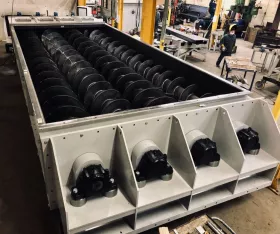
At 11m long and weighing over 18T, the physical proportions of the screw feeder also presented a challenge. The feeder was fully assembled at Ajax’s works for a factory acceptance tests and inspection by Enviropower but was made in kit form allowing the components to be transported in sections and assembled on site.
Following the successful performance of the first quadruple screw feeder, Enviropower contacted Ajax in 2021 to order an identical feeder for the facility’s other processing line. Commenting, Marc Linberry, operations director at Enviropower, said, “Ajax worked closely with us to overcome a couple of teething problems with the first quadruple screw feeder, and their fast response and determination to overcome these issues and provide us with reliable and well-functioning equipment left us with no doubt but to return to them when we wanted an identical system for our other biomass waste processing line.”
Six Screws - Carbon Fibre Handling
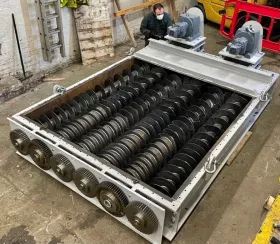
Following Ajax’s supply of a hopper and single screw feeder on a successful upgrade of an existing milled carbon fibre handling line at Mersen’s Eurocentral, UK facility, Ajax Equipment was asked to design another system for a new line handling carbon fibre. “After the success of working with Ajax to upgrade the existing line we were happy to work with them again on this new line,” said Scott Keil, manufacturing manager at Mersen.
A new line provides the opportunity to design each component of the system together, ensuring efficiency of process and plant configuration. The new line’s extremely low density and very fibrous material had long thin particle shapes making it poorly flowing, very different to milled carbon fibre of the existing line. As a result of the difference, property tests were performed helping inform the design of the storage and transfer system needs for carbon fibre on Mersen’s additional line.
Mersen’s process required the carbon fibre to be stored in a large silo; due to the materials resistance to flow, the silo’s walls could not have any convergence as sloping walls would cause the material’s long and thin fibrous particles to arch and form a blockage over the outlet.
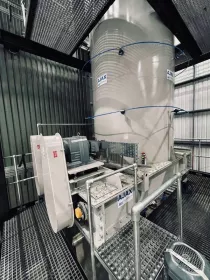
For the vertical walled silo, a fully live multi-screw feeder was required to extract the carbon fibre from the silo and prevent any hold-up of material.
To achieve this, Ajax designed a silo and six screwed feeder, driven as a pair of triple screws. The integrated design of the feeder and silo means that any arching and hold up of fibre is completely avoided and a positive, regulated feed is consistently achieved. Ajax’s carbon fibre handling system also included a collecting screw conveyor with declumping features and an inclined screw.
“Commissioning with the new multi-screw system has gone exceptionally well with production totally satisfied that the Ajax feed of product to our mill is consistent and indeed superior to our original Silo set up,” commented Scott.
■









